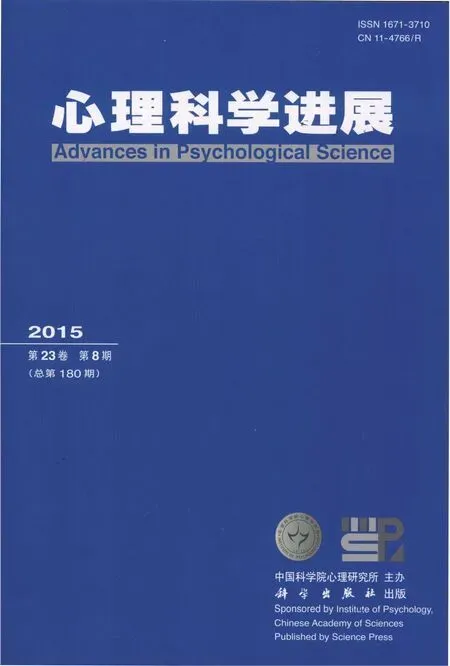自杀行为:影响因素、理论模型及研究展望*
(青少年网络心理与行为教育部重点实验室,华中师范大学心理学院,湖北省人的发展与心理健康重点实验室,武汉430079)
自杀行为(suicidal behavior),包括与自杀有关的想法、非致命性自杀企图和致命性的自杀(Silverman,Berman,Sanddal,O'Carroll,&Joiner,2007)。自杀行为,不仅让每个家庭遭受巨大的悲痛,也对社会造成极大的负面影响。研究者们一直致力于找出自杀行为的影响因素,近10年以来相关研究迅速增加。以“suicide”为检索词在美国心理学会期刊全文数据库(EBSCO PsychARTICLES)中搜索,1995~2004年期间出版的文章有15325篇,2005年至今已增至有 30247篇。与此相比,国内的自杀研究起步较晚,尚未引起多数研究者及实践者的关注。
因此,本文将对国外该领域的主要研究内容进行评述性介绍,包括概念界定、流行病学调查结果、自杀行为的影响因素及理论模型构建,并指出未来研究方向,供国内同仁参考。
1 术语及概念界定
自杀行为主要包括自杀意念、自杀企图和自杀。然而,自杀行为研究领域中并非仅有这 3个术语。有研究者统计,自杀意念的术语有 9个,如:suicidal ideation、suicidal thoughts、suicidal ideology与suicidal preoccupations;自杀企图的术语有36个之多,如:suicidal attempt、deliberate self-harm、non-lethal suicide与parasuicide等;而自杀的术语有 27 个,如:suicide、committed suicide、completed suicide、lethal suicide attempt与self-inflicted suicide等(Silverman,2006)。其中,suicidal ideation、suicdal attempet和suicide出现频率最高。
在概念界定方面,自杀意念是指那些丧失活下去的愿望,但还没有导致身体受伤的自杀构想与行为(Beck et al.,1973);自杀企图是指非致命性结果的自我伤害行为,具有一定程度的自杀意图,其结果可能是受伤或没有受伤(O'Carroll et al.,1996)。相对而言,自杀的定义尚未统一。有研究者统计发现,自杀的定义有15个之多,这些定义理论背景各不相同,如:社会学、心理学、精神病学、哲学及公共卫生(De Leo,Burgis,Bertolote,Kerkhof,&Bille-Brahe,2006;Silverman,2006)。虽然自杀的定义繁多,但研究者逐渐在 3个方面达成共识:(1)自己造成的;(2)有意的;(3)结果具有致命性(De Leo et al.,2006;Marušič,2004)。
2 流行病学
由于样本与调查工具的不同,中西方的自杀意念发生率存在一定差异。西方多采用单项目调查,如“是否严肃考虑过杀死自己?”(Crosby,Han,Ortega,Parks,&Gfroerer,2011)。我国多采用问卷调查,如“Beck自杀意念量表”、“积极与消极自杀意念问卷”。西方调查结果表明,自杀意念的发生率在18岁以下约为15~30.8%(Kokkevi,Rotsika,Arapaki,&Richardson,2012;Nock et al.,2008),18岁之后急剧下降,约为3.7~14.3%(Crosby et al.,2011;Nock et al.,2008)。我国的调查结果表明,大学生的自杀意念发生率为12.9~20.5%(李献云等,2011;梁瑛楠,杨丽珠,2011);社区人群的自杀意念发生率为7.9%(李献云等,2010)。
西方18岁以下人群中,自杀企图的发生率约为3.1~8.8%,18岁以上为1.9~8.7%(Nock et al.,2008)。我国18岁以上人群中,自杀企图的发生率在河北省为 0.82%(孙秀丽等,2010),厦门市为0.55%(王文强,丁丽君,温程,廖震华,吴素英,2012),显著低于西方国家。
尽管中西方的自杀意念与自杀企图的发生率不同,但调查结果一致表明,女性的自杀意念与自杀企图的发生率均显著高于男性(Crosby et al.,2011;Nock et al.,2008;梁瑛楠,杨丽珠,2011;孙秀丽等,2010;王文强等,2012)。
WHO(2014)的统计数据表明,2012年全球范围内总体自杀率约十万分之 11.4,15岁以下的人群自杀率最低,而70岁以上的自杀率最高,男性的自杀率显著高于女性,其比率约为3:1。Phillips,Li和Zhang(2002)的调查结果表明,1995~1999年我国的自杀率为十万分之 23.2,女性自杀率高出男性25%。Wang,Chan和Yip(2014)的调查结果表明,2009~2011年我国的自杀率约为十万分之9.8,男性略高于女性。两项调查一致表明,老年人的自杀率最高,尤其是农村老年居民。与西方国家相比,近年来我国的自杀特点是:(1)自杀率显著下降,尤其是女性;(2)农村自杀率始终高于城市;(3)老年居民是自杀的高危人群。
3 主要影响因素
目前,研究发现自杀行为的影响因素众多(O'Connor &Nock,2014;van Heeringen &Mann,2014),大致可以分为三类:生物学因素、精神障碍和心理因素。
3.1 生物学因素
双生子研究和家族研究均表明遗传对自杀行为有重要的影响(Geulayov,Gunnell,Holmen,&Metcalfe,2012;Pedersen &Fiske,2010)。有研究表明,约30~50%的自杀风险是遗传因素造成,然而特定的基因尚未确定(van Heeringen &Mann,2014)。
尽管目前尚未确定是哪些基因影响着自杀行为,但研究者发现与自杀行为相关的生物学因素会增加基因与环境的相互作用(van Heeringen &Mann,2014)。抑制神经传递的血清素功能紊乱是与自杀行为联系最密切的生物学因素(Antypa,Serretti,&Rujescu,2013)。然而,抑郁和冲动暴力行为同样存在着血清素激活功能不足(Bortolato et al.,2013;Mann,2013)。因此,这并非自杀行为所独有的生物学现象。
3.2 精神障碍
约 90%的自杀死亡者中至少有一种精神障碍(Bertolote,2003;Cavanagh,Carson,Sharpe,&Lawrie,2003)。Harris和 Barraclough(1997)对 249篇自杀死亡与精神障碍有关的文献进行元分析,发现44种精神障碍中有36种会显著增加自杀率。依据病因将精神障碍分为三类:器质性异常、物质滥用障碍和功能性精神障碍,三者的自杀死亡比率为1:2:4(Harris &Barralough,1997)。
自杀者最常见的精神障碍是抑郁症(Conner et al.,2013;Rihmer,2011;Slama,Merle,Ursulet,Charles-Nicolas,&Ballon,2011)。50%以上的自杀死亡者为抑郁症(Bertolote,2003),20~48%的自杀企图者为抑郁症(Oquendo,Lizardi,Greenwald,Weissman,&Mann,2004;Slama et al.,2011;Suokas et al.,2010),而抑郁症患者死于自杀的比率为2.2~6.2%(Bostwick &Pankratz,2000;Qin,2011)。Harris和Barraclough(1997)的元分析表明,控制人口学特征后抑郁患者中死于自杀的风险是非抑郁患者的20倍。血清素功能失调可能是抑郁症与自杀密切相关的生理基础(Mann,2013),而绝望也许是连接二者的重要心理因素。
除抑郁症外,精神分裂症、惊恐障碍、物质滥用及边缘型人格障碍患者也具有较高的自杀风险(Blasco-Fontecilla et al.,2009;Harris &Barralough,1997;Palmer,Pankratz,&Bostwick,2005;Pompili,Girardi,Ruberto,&Tatarelli,2005)。实际上,Harris和 Barraclough(1997)的元分析发现除了智力迟钝、痴呆和旷野恐怖症,几乎所有的精神障碍都会增加自杀的风险。并且,精神障碍共病的数量越多,自杀风险就越高(Nock,Hwang,Sampson,&Kessler,2010),甚至共病的数量比共病的类型更具有预测力(Kessler,Borges,&Walters,1999)。
3.3 心理因素
尽管 90%的自杀者有精神障碍,但精神障碍患者中自杀的比率仅有5%(Bostwick &Pankratz,2000)。大部分精神障碍患者并不会自杀,甚至没有自杀企图。研究者认为,心理因素能解释为何有些人会自杀,而另一些人却不这样。从人格、认知和情绪情感的角度对影响自杀行为的心理因素进行梳理,可以分为:易损特质、失调认知和心理痛苦。
3.3.1 易损特质
自杀行为的易损特质主要是指与人格特质有关的完美主义及冲动性。易损特质为自杀行为的发生提供素质基础。
(1) 完美主义
完美主义是指个体追求凡事都做到尽善尽美的倾向,为自己或他人设定了不切实际的高标准,且以是否达到这些标准来对自己或他人作出评价。完美主义有3个维度:自我取向、他人取向和社会决定(Hewitt &Flett,1991)。O’Connor(2007)回顾了 29篇完美主义与自杀的研究,发现社会决定完美主义与自杀行为的关系密切,而其他维度的完美主义与自杀行为的关系并不一致。并且,多项研究表明,在控制抑郁与绝望后,社会决定完美主义与自杀行为仍有显著相关(Dean,Range,&Goggin,1996;Hewitt,Flett,&Weber,1994),甚至能预测 6个月后的自杀意念(Beevers&Miller,2004)。
此外,完美主义与其他影响因素相互作用,共同增加自杀行为的风险。研究表明,面临生活压力与学业困难,社会决定完美主义水平较高者的自杀意念较多(Blankstein,Lumley,&Crawford,2007;Hewitt et al.,1994)。社会决定完美主义对行为抑制动机与自杀意念起中介作用(Rasmussen,Elliott,&O'Connor,2012)。社会决定完美主义与过度概括化记忆的交互作用能预测自杀意念(Rasmussen,O'Connor,&Brodie,2008)。而 Wang,Wong和 Fu(2013)的研究发现,完美主义增加了累赘感和未满足的归属感对自杀意念的影响。
(2) 冲动性
美国自杀协会(American Association of Suicidology)将冲动性列为自杀的风险因子。然而,冲动性与自杀的关系是模棱两可的(Wenzel,Brown,&Beck,2009)。
多项研究表明,冲动性与自杀行为有密切的联系(Doihara et al.,2012;Klonsky &May,2010;Nock &Kessler,2006)。然而,也有研究发现,冲动型自杀行为与自杀者的冲动性特质之间没有显著的相关(Baca-Garcia et al.,2005;Giegling et al.,2009;Wyder &De Leo,2007)。甚至,有计划的自杀组冲动性特质水平高于无计划的自杀组(Witte et al.,2008)。
造成这种不确定关系的原因可能有两个:第一,特质冲动与状态冲动二者之间存在差异。特质冲动是个体快速决策,不计后果,也无事先的计划(Wenzel et al.,2009),而状态特质是个体在特定情境下的行为风格(Dougherty et al.,2004;Swann et al.,2005)。因此,冲动型自杀与自杀者冲动性有重叠,但不完全相同。第二,冲动性与自杀之间还存在其他变量。有研究发现,冲动性在痛苦与刺激事件及获得自杀能力之间起中介作用(Bender,Gordon,Bresin,&Joiner,2011),而自杀能力是自杀企图和自杀的影响因素(van Orden et al.,2010)。
3.3.2 失调认知
失调的认知包括两个方面的内容:(1)不良的认知图式,如:绝望;(2)偏差的认知加工方式,如:认知僵化、过度概括的自传记忆和问题解决不足。
(1) 绝望
绝望是指对获得某种目标有较低的期待,以及对获得成功有较少信念,是一种对未来消极期待的认知图式(Beck,Weissman,Lester,&Trexler,1974)。McMillan,Gilbody,Beresford和 Neilly(2007)的元分析发现绝望至少会增加 3倍的最终自杀风险。控制抑郁水平后,绝望与自杀意念及自杀企图仍有显著相关(Panagioti,Gooding,&Tarrier,2012;Suominen,Isometsä,Ostamo,&Lönnqvist,2004)。这说明,绝望与自杀的关系并非抑郁所致。并且,持续稳定的绝望相对偶然一次的绝望更能预测自杀行为(Dahlsgaard,Beck,&Brown,1998;Young et al.,1996)。
然而,绝望预测自杀的追踪研究结果并不一致。Beck,Steer,Kovacs和Garrison(1985)对有自杀意念住院患者进行长达10年的追踪研究,发现绝望预测自杀的准确性高达 91%。Sokero等人(2006)为期 26周的追踪研究发现,控制抑郁水平后,绝望仍能预测自杀意念。但是有两项长达 10年以上的追踪研究表明,绝望并不能预测最终的自杀(Beck &Steer,1989;Suominen et al.,2004)。另有研究发现,绝望与自杀意念存在强烈的同步关系,而非预测纵向关系(Shahar,Bareket,Rudd,&Joiner,2006)。这说明绝望可能是自杀的伴随状态,而非因果关系。
与此同时,一些研究者将目光投向“希望”,一个与绝望相对的概念。希望是指一种基于内在成功感的积极动机状态,由意愿动力和路径两部分组成(Snyder,1995)。希望并非绝望的反向情感,低希望意味着对未来缺乏积极情感,而绝望则意味着对未来有较多的消极情感(Snyder et al.,1991)。已有的研究表明,希望与自杀意念呈显著负相关(Davidson,Wingate,Slish,&Rasmus,2010;O'Keefe &Wingate,2013;安静等,2012),并且希望能调节反刍与自杀意念的关系(Tucker et al.,2013;刘旺,田丽丽,陆红,2014)。这说明希望能起到减少自杀意念发生的可能性。
(2) 认知僵化
认知僵化是指不能适应外在反馈及环境因素来改变决策行为。临床和理论研究者发现,自杀者认知僵化,他们认为自杀是唯一的选择。Marzuk,Hartwell,Leon和Portera(2005)以抑郁症患者为被试,控制早期自杀企图的次数、年龄、抑郁及言语智力后,发现当前有自杀意念组的认知僵化水平显著高于无自杀意念组。同样以抑郁患者为被试,自杀企图组比起无自杀企图组的认知僵化水平更高(Keilp et al.,2013)。还有研究发现,自杀方式的致命程度较高者,认知僵化水平也比较高(Keilp et al.,2001)。
追踪研究发现,早期有过自杀企图的个体,认知僵化能预测 6个月后的自杀意念(Miranda,Gallagher,Bauchner,Vaysman,&Marroquin,2012)。另一项研究发现,认知僵化能预测 2~3年后的自杀意念,并且认知僵化增加更多的反刍与绝望,进而产生更多的自杀意念(Miranda,Valderrama,Tsypes,Gadol,&Gallagher,2013)。
(3) 过度概括的自传记忆
自传记忆(autobiographical memory)是个人对过去生活事件的回忆(Rubin,2005)。多项研究表明,自杀者具有过度概括的自传记忆特点(Williams,Barnhofer,Crane,&Beck,2005;Williams et al.,2007;Williams &Broadbent,1986;Williams &Dritschel,1988)。
然而,过度概括化的自传记忆并非仅限于自杀者。Williams等(2007)元分析发现,抑郁、创伤性应激障碍与过度概括的自传记忆也有着稳定的联系。Leibetseder,Rohrer,Mackinger和Fartacek(2006)试图进一步了解抑郁、自杀和自传记忆之间的关系,发现重度抑郁症患者(无论有无自杀企图)与有过自杀企图者(但没有情感障碍)相比,提取具体自传记忆时受损情况相同。这说明,过度概括的自传记忆是自杀与抑郁的共同易损因子。但依据当前的研究结果,难以发现精神障碍(尤其是抑郁症)对自杀者的自传记忆受损是否起作用,或起多大的作用。
自传记忆受损与另一个失调认知特点有着密切的关联:问题解决不足。
(4) 问题解决不足
自杀者普遍认为生活没有出路而选择自杀,这种现象让研究者关注问题解决与自杀行为的关系。问题解决不足体现在两个方面:(1)问题解决的能力或技能不足;(2)个体对自身问题解决能力的评估水平较低。
自杀者的问题解决能力不足主要体现在人际方面(Williams et al.,2005),具体表现有:有效的问题解决策略较少(Pollock &Williams,2004;Priester &Clum,1993;Schotte &Clum,1982,1987);更关注负性结果(Schotte &Clum,1987);回避尝试解决问题(Orbach,Bar-Joseph,&Dror,1990);对任务的反应时更长(Kaviani,Rahimi-Darabad,&Naghavi,2005)。自杀者的问题解决能力不足并非智力或精神障碍(如:抑郁)所造成的,因此研究者认为它是自杀者独有的认知特点(Biggam &Power,1999;Pollock &Williams,2001;Williams et al.,2005)。
有研究表明,过度概括的自传体记忆、较差的人际问题解决与自杀之间有显著相关(Arie,Apter,Orbach,Yefet,&Zalsman,2008)。在自传记忆受损的作用下,自杀者提取的具体记忆较少,应对策略相应减少,从而出现问题解决困难的现象。并且,自杀企图者的自传记忆概括化程度越高,问题解决的效率越低,解决的策略数量也越少(Pollock &Williams,2001;Williams et al.,2005)。
研究还发现,个体对自身问题解决能力的评估与自杀行为有关。个体对自己问题解决的自信程度越低,越容易产生绝望与自杀意念(Dixon,Heppner,&Anderson,1991;Priester &Clum,1993)。进一步研究发现,问题解决评估通过绝望影响自杀意念(Dixon,Heppner,&Rudd,1994)。不仅是自杀意念,较低的问题解决评估也与自杀企图显著相关(Rudd,Rajab,&Dahm,1994)。Gibbs等(2009)的研究以抑郁老年患者为被试,发现有过自杀企图组比起非自杀企图组,更倾向知觉整体的问题解决不足,知觉更消极。
然而,追踪研究表明,在压力情景下,基线水平的问题解决评估能预测两周内的抑郁与绝望,但不能预测自杀意念(Priester &Clum,1993)。而Grover等(2009)的研究发现,问题解决不足能预测自杀意念,但不能预测自杀企图。并且,问题解决可以调节压力与自杀意念的关系,但不能调节压力与自杀企图。
3.3.3 心理痛苦
Shneidman(1993)提出心理痛苦(psychache)的概念,它是指一种由心理需要受阻或没有实现引起的被羞辱、内疚、愤怒、孤独以及绝望等精神痛苦的状态。当这种精神痛苦的程度超过个体所能承受的最大限度,个体会将自杀视为终止这种不可承受的意识流动的唯一方法,从而发生自杀行为。Shneidman认为心理痛苦是引发自杀的直接原因,而其他因素,如抑郁与绝望,只有与心理痛苦相联系才与自杀相关。
研究发现,控制绝望和抑郁后,心理痛苦与自杀意念仍然显著相关(Pereira,Kroner,Holden,&Flamenbaum,2010),并且相关程度高于绝望、抑郁与自杀意念的相关(Troister &Holden,2010)。还有研究表明,心理痛苦对绝望、抑郁与自杀起中介作用,是与自杀最接近的因素(DeLisle &Holden,2009)。此外,心理痛苦对社会决定完美主义与自杀的关系起完全中介作用(Flamenbaum &Holden,2007)。但是,对于自杀意念、自杀动机及自杀准备,抑郁与绝望在控制心理痛苦之后仍有显著的贡献率(Troister &Holden,2010)。因此,Shneidman的理论观点并未得到完全支持。
追踪研究表明,基线水平的心理痛苦能预测2年后的自杀意念,但抑郁与绝望不能(Troister &Holden,2012)。另一项研究表明,控制抑郁和绝望后,心理痛苦能预测 5个月后的自杀意念与自杀准备(Troister,Davis,Lowndes,&Holden,2013)。这说明,心理痛苦与自杀可能存在因果关系。
从这些研究结果来看,心理痛苦是解释自杀行为的重要因素,但它并非唯一因素。
3.4 小结
自杀是一个复杂的病理性行为,影响因素众多,是生物学因素、精神障碍及心理因素共同作用的结果。以目前的研究结果来看,尚未发现哪个因素能完全解释自杀行为。事实是,这些影响因素的累积及相互作用增加了自杀风险。
Joiner,Brown和 Wingate(2005)认为自杀行为的影响因素可以分为两大类:(1)无法抑制的冲动;(2)强烈的心理痛苦倾向。通过前文对自杀行为影响因素的述评,可以从三个方面找到证据:其一,从生物学因素来看,血清素功能失调与自杀行为有密切的关联,但它同时也是冲动性及抑郁症状的生物学基础;其二,从精神障碍方面来看,除了智力迟钝、痴呆及旷野恐怖症,几乎所有的精神障碍都会增加自杀的风险。而精神障碍往往以冲动控制障碍及强烈情绪为特征;其三,从心理因素来看,冲动性和心理痛苦都是自杀者的心理特点。同时,完美主义会增加个体的心理痛苦感受,而失调认知会在冲动和心理痛苦方面起着推波助澜的作用。综合来看,这三方面的影响因素相互作用,促使个体陷入难以抑制的冲动和无法忍受的心理痛苦,最终走向自杀。
4 理论研究与证据
随着自杀行为影响因素的研究成果不断积累,研究者开始着眼于从系统的、深层次的角度理解自杀行为。自杀行为的理论模型依据一定的理论取向解释影响因素(主要是心理因素)之间的关系,进而剖析自杀行为的发生发展机制。
4.1 自杀差异激活理论(Differential Activation Theory of Suicidality)
自杀差异激活理论(Lau,Segal,&Williams,2004)用于解释自杀意念及行为反复出现的现象,其理论基础是 Teasdale(1988)的抑郁差异激活理论。Teasdale认为抑郁发作期间,悲伤情绪、负性失调信念和认知过程偏差之间建立了联结。每一次抑郁发作时,这种联结会被强化并更易触发。其结果是,很小的悲伤情绪会激活负性失调的信念,促使抑郁复发。如果被激活的内容是全局的、负面的与自我相关的,那么抑郁就极有可能复发。而自杀意念是一种最能代表全局的、负面的与自我有关的思维模式。因此,一旦抑郁早期发作时出现过自杀意念或企图,那么复发时会再次出现。抑郁早期发作时,抑郁情绪与自杀意念形成的联结,即使抑郁恢复,这种联结仍然是潜在的。抑郁复发时,自杀意念会被激活。而每次激活后,自杀意念会变得越来越容易出现。因此,轻微的情绪低落,或信息加工偏差都会再次引发自杀意念。
目前,有几项研究支持该理论的主要观点。Williams,Crane,Barnhofer,van der Does和Segal(2006)发现抑郁症复发时,所有的抑郁症状中自杀意念再次出现的一致性最高。这说明抑郁复发与自杀意念的再次出现有着密切的关联。William等(2005)的研究表明,在情绪干扰的作用下,早期有过自杀企图但现在已经康复的被试比起从未有过自杀企图的被试,在问题解决方面仍然表现更差。William,van der Does,Barnhofer,Crane和Segal(2008)另一项研究发现,对于早期抑郁并有过自杀意念,但现在无自杀意念的被试,即使微小的情绪波动仍能激活与绝望有关的认知加工。Palmier-Claus,Taylor,Gooding,Dunn和Lewis(2012)的研究发现,不稳定的情绪能引发较高频率与较严重的自杀意念。这些研究说明,抑郁早期发作时,抑郁情绪、信息加工模式及自杀意念之间建立了联结。
4.2 自杀人际理论(Interpersonal Theory of Suicide)
Joiner(2007)提出自杀人际理论,从人际关系的角度解释自杀愿望如何发展为自杀(企图)。该理论认为,个体仅有自杀的愿望并不会自杀,只有同时具备实现愿望的能力,才会自杀,如图1所示。
自杀愿望的产生来源于两种人际状态:累赘感(perceived burdensomeness)和未满足的归属感(thwarted belongingness)。累赘感是指个体错误的知觉自己的无能会给朋友、家人及社会造成负担,这种负担的感受使个体相信自己死了比活着更有价值(Joiner et al.,2009)。未满足的归属感是指个体基本的、与他人联结的需要未获得满足时所产生的心理痛苦状态(van Orden,Cukrowicz,Witte,&Joiner,2012)。该理论认为,累赘感与未满足的归属感会引发自杀意念的产生,当二者同时存在时,自杀意念达到最高水平。
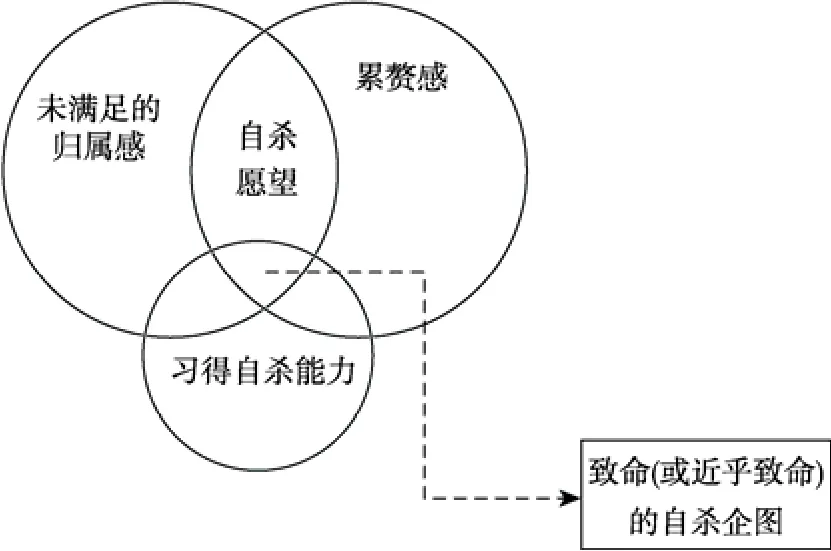
图1 自杀人际理论(van Orden et al.,2010)
自杀人际理论认为,由于自杀威胁生存,人类天生就惧怕自杀。因此,个体要实施自杀,必须要克服恐惧与疼痛,并习得自杀能力(acquired capability for suicide),才能将自杀愿望转变为现实。通过反复多次接触痛苦与刺激的事件,可以降低对死亡的恐惧,并提高身体疼痛的容忍度,从而习得自杀能力。习得自杀能力的内在机制是对痛苦、恐惧及疼痛的习惯化与拮抗作用(van Orden et al.,2010)。
自杀人际理论有两个突出的特点:第一,关注自杀愿望如何转变为现实,即自杀意念变为自杀企图;第二,从人际关系的角度理解自杀行为。实证研究有一些支持该理论(Bryan,Morrow,Anestis,&Joiner,2010;Christensen,Batterham,Soubelet,&Mackinnon,2013;Cukrowicz,Cheavens,van Orden,Ragain,&Cook,2011;Monteith,Menefee,Pettit,Leopoulos,&Vincent,2013;Smith,Cukrowicz,Poindexter,Hobson,&Cohen,2010),但也有一些不支持(Bryan,Clemans,&Hernandez,2012;Gunn,Lester,Haines,&Williams,2012;Smith,Wolford-Clevenger,Mandracchia,&Jahn,2013)。这说明该理论可能只适用一部分自杀人群,或者还有其他未考虑的重要影响因素。而且,累赘感与未满足的归属感之间的关系并不十分清楚。此外,习得自杀能力是否是自杀者所必备的能力,以及该理论是否适用中国文化背景,还有待进一步的考证。
4.3 自杀行为的认知模型(Cognitive model of suicidal behavior)
Wenzel和 Beck(2008)整合当前大量认知方面的研究成果,提出自杀行为认知模型。该模型包含三个部分:素质易损因子、精神异常认知过程和自杀行为认知过程,如图2所示。素质易损因子是指长期存在的、类似特质的、与精神障碍风险及自杀行为有关的因素,如:冲动性、问题解决不足、完美主义、不良的态度和过度概括记忆。精神异常认知过程是指与精神障碍及症状相关的不良认知内容(如:人们想什么)和信息加工偏差(如:人们如何思考)。自杀行为的认知过程是指个体处于自杀危机时的不良认知内容和信息加工。
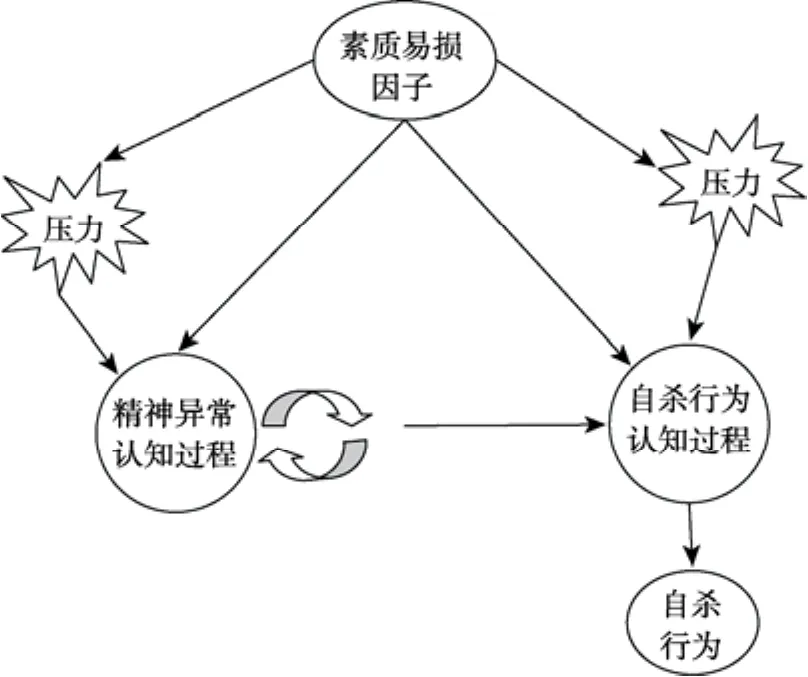
图2 自杀行为的认知模型(Wenzel &Beck,2008)
模型认为,素质易损因子通过三种方式影响自杀行为。其一,引发生活压力,激活精神障碍的症状与自杀危机。其二,加剧精神障碍的认知过程,从而触发自杀危机。其三,削弱个体应对的能力,并破坏自杀危机中适宜的认知过程。素质易损因子以一种联合的方式激活精神异常与自杀行为的认知过程。这不仅指多种易损因子的累积会加剧自杀行为的可能性,还说明有多种途径在发挥作用。
个体的图式是精神异常和自杀行为的认知过程的基础,与精神干扰相联系的图式是使信息加工偏差的基础。素质易损因子和压力通过激活精神异常的图式,进而激活自杀图式,即自杀行为的认知过程。
自杀图式的激活会触发自杀行为的认知过程。自杀图式至少有两类:特质绝望和无法忍受性,如图3所示。无论哪个自杀图式被激活,个体会体验到更多的状态绝望。自杀图式、状态绝望、注意固着和选择注意自杀线索相互作用,形成一个认知情感漩涡,进而产生自杀意念,如图4所示。当自杀个体处于绝望状态时,问题解决的策略会减少。因此,个体将自杀作为解决问题的策略,而不是系统的考虑其他的策略。个体越固着自杀是唯一的解决策略,越感到绝望,对无法忍受的知觉就越多。状态绝望的增加会削弱个体的判断力,强化“没有出路”的信念。换句话说,状态绝望与注意固着之间存在着双向的作用。当个体所能忍受的认知情绪状态超过阈限时,自杀企图便出现了。
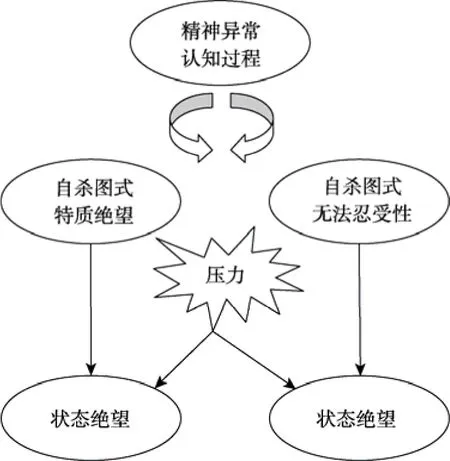
图3 自杀图式与状态绝望(Wenzel &Beck,2008)
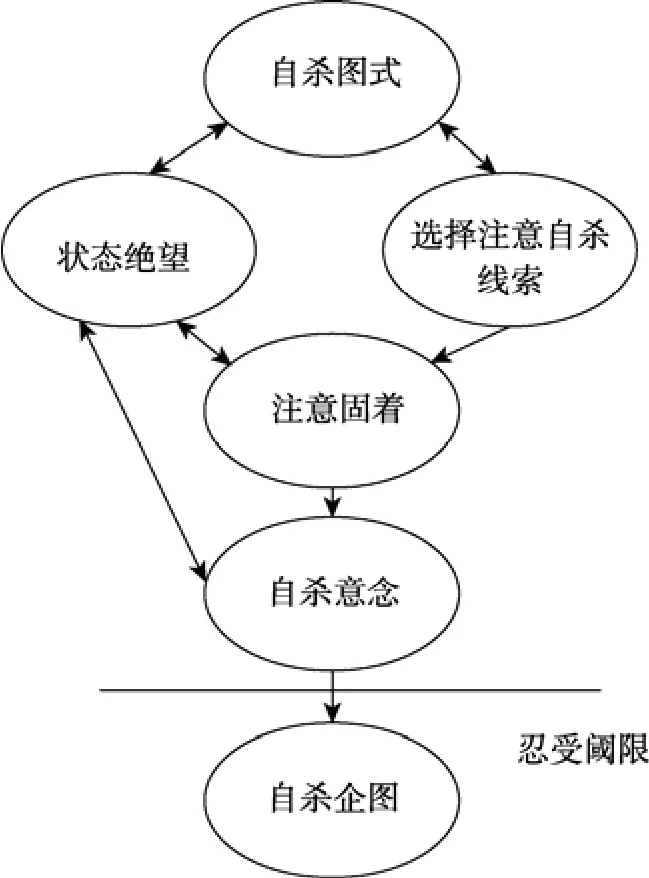
图4 自杀行为认知过程(Wenzel &Beck,2008)
4.4 自杀图式评估模型(Schematic Appraisal Mo del of Suicide,SAMS)
Johnson,Gooding和Tarrier(2008)提出自杀图式评估模型,主要包括:负性信息加工偏差、自杀图式和评估系统。
SAMS认为负性信息加工偏差对于维持负性情绪状态、获取自杀相关信息起重要作用。负性信息加工偏差的结果是激活自杀图式,并与自杀图式一起影响评估系统。评估系统包括对现在、过去、未来及个人属性的评估。自杀图式被激活后,个体会产生自杀意念,认为自杀可以逃离无法忍受的情绪或状态。自杀图式激活后,会抑制其他图式,如危害较小的逃离图式、或目标更合适的认知与行为。自杀图式越强大、越复杂,就越能抑制其他图式,产生自杀行为。实证研究表明,自杀企图的次数越多,自杀图式越复杂(Pratt,Gooding,Johnson,Taylor,&Tarrier,2010)。
SAMS认为负性信息加工偏差,自杀图式及评估系统相互作用产生了挫败(defeat)与受困(entrapment),从而产生自杀行为。挫败,是指对失败的社会竞争、丧失及社会等级下降的感受(Gilbert &Allan,1998),可能与直接的人际冲突有关,也可能与知觉到无法获得社会资源(包括物质资源)有关(Gilbert,2006)。受困,是指逃离当前情境的愿望,但知觉所有的逃离路径全被堵死(Gilbert &Allan,1998)。挫败与受困来自评估系统偏差的结果。个体为了逃避无法忍受的挫败与受困,而选择自杀。Taylor,Gooding,Wood和Tarrier(2011)的元分析表明,挫败、受困与自杀有着稳定且可靠的关系。大量研究表明,挫败与受困能解释评估系统与自杀风险之间的关系,并且在控制绝望与抑郁后还能解释较高自杀风险的变异(O’Connor,Smyth,Ferguson,Ryan,&Williams,2013;Panagioti,Gooding,&Tarrier,2012;Panagioti,Gooding,Taylor,&Tarrier,2012,2013;Taylor,Gooding,et al.,2010;Taylor,Wood,Gooding,&Tarrier,2010)。
4.5 动机-意志整合模型(Integrated Motivational-Volitional Model of Suicidal Behaviour,IMV)
O’Connor(2011)提出动机-意志整合模型。IMV以计划行为理论、素质-压力模型及痛苦呼救模型为主要理论基础,整合了当今主要自杀理论及实证研究的大量成果。IMV的大框架以计划行为理论为基础,认为自杀行为的发展有三个阶段:前动机阶段、动机阶段和意志阶段,如图5所示。前动机阶段包括自杀的背景因素和扳机事件;动机阶段为行为意图形成阶段,即自杀意念与意图的形成阶段;而意志阶段为意图实施阶段,即自杀意图转变为自杀企图或自杀。
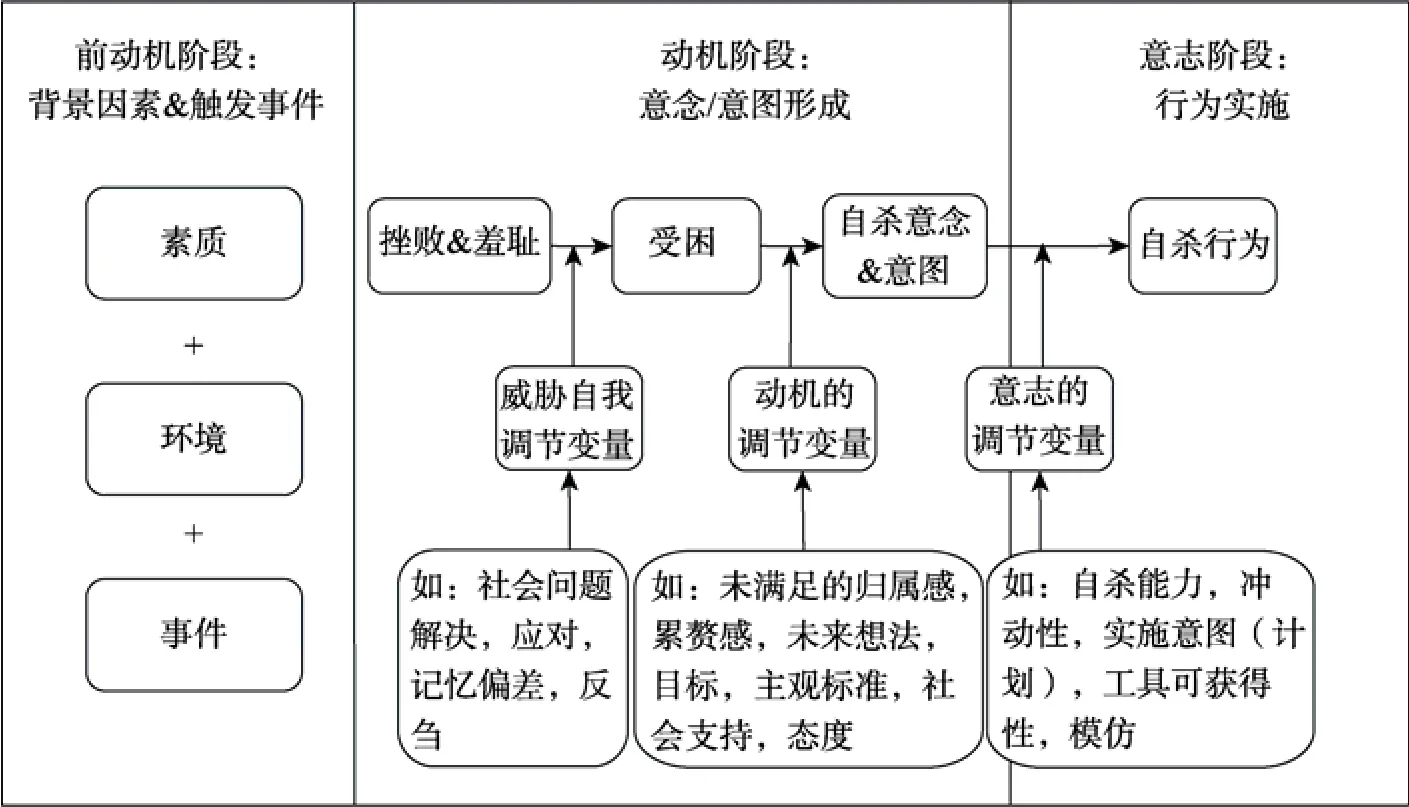
图5 自杀行为的动机-意志整合模型(O’Connor,2011)
前动机阶段是以素质-压力模型为基础。素质是生物的或基因的易损因素,压力主要包括环境因素(如剥夺)及负性生活事件(如关系破裂)。
动机阶段是自杀意念和意图的形成阶段,以痛苦呼救模型为理论基础。自杀意念的产生来自于受困,而受困由挫败或羞耻的体验所引发。IMV认为在挫败或羞耻发展为受困的过程中,威胁自我的变量起到调节作用,如社会问题解决、应对、记忆偏差及反刍。而受困发展为自杀意念与意图的过程中,动机变量起到调节作用,如:未满足的归属感、累赘感、未来想法、目标管理、主观标准、社会支持及态度。
意志阶段是行为实施阶段,理论基础源于计划行为理论、痛苦呼救模型及自杀人际理论。在这一阶段,自杀意念转变为自杀企图或自杀,意志变量起调节作用,如:自杀能力、冲动性、实施意图(计划)、工具可获得性及模仿。
总体而言,IMV以当前的自杀理论和实证研究成果为基础,整合了自杀行为的病因及发展过程中的生物与心理因素。IMV将自杀看作是个体有意识计划并实施的行为,而不是心理疾病或病理的表现。模型将自杀意念与自杀行为的影响因素区分开来,有助于深入理解自杀。
4.6 小结
总体而言,研究者试图跨越生物学因素及精神障碍,从心理学的角度深层次解释自杀行为。但不同研究者的视角略有不同。自杀差异激活理论是从抑郁症周期复发的角度解释自杀意念及自杀企图重复出现的现象。自杀人际理论是从人类基本需要——归属——的角度探讨自杀意念及自杀企图/自杀的形成机制。自杀行为的认知模型与自杀图式评估模型都是从认知心理学的角度解析自杀,自杀图式是这两个理论的重要组成部分。但前者关注自杀图式的内容,而后者侧重自杀图式的结构。从研究结果来看,以上理论都略显片面。而动机—意志整合模型是以计划行为理论为基础,几乎囊括了当前所有自杀行为的理论及实证研究的成果,是一个“大”而“全”的理论模型。
可以看出,自杀理论模型的构建由局部走向整体,由分化走向整合。分化与整合,各有利弊。分化,更细致、更深入,但缺乏全景观。整合,更全面,但难深入,并且,整合模型涉及更多的变量,关系更复杂,容易造成研究结果难以解释。
5 评论与研究展望
5.1 自杀行为的“过程”观
自杀行为是众多影响因素相互作用,不断累积发展的结果。换句话说,自杀行为的形成不是一时的或短暂的,而是历经了一个过程。自杀行为是以易损特质(如冲动性,完美主义)为基点,在负性认知(如累赘感,未满足的归属感)及消极情绪(如抑郁)的作用下,激活自杀图式(如绝望),最终产生自杀意念与自杀企图/自杀。自杀人际理论、自杀行为的认知模型、自杀图式评估模型以及动机——意志整合模型,都体现出这种自杀的“过程”观。
“过程”观对于研究与临床干预有指导意义。从研究的角度来看,“过程”观提示研究者应按阶段来探讨自杀行为形成的机制,不同阶段有哪些因素,如何相互作用,一个阶段在何种情况下会进入到下一个阶段。从临床干预的角度来看,“过程”观提示干预工作者需按照不同阶段评估自杀风险,有利于开展针对性的预防及干预工作。
5.2 “意念”至“行动”的研究趋势
自杀意念向自杀(企图)的转变机制是研究的发展趋势。目前的研究大多将自杀意念、自杀企图或自杀死亡作为因变量,较少探讨自杀意念转向自杀企图或自杀的内部机制。
从流行学调查结果来看,自杀意念的发生率远远高于自杀企图,而自杀企图的发生率又远远高于自杀死亡(Crosby et al.,2011;Nock et al.,2008)。从实证研究结果来看,有过自杀企图的个体比仅仅只有自杀意念的个体在抑郁和绝望水平上并无较多的差异(McManama O'Brien,Becker,Spirito,Simon,&Prinstein,2014;Nock &Kazdin,2002;Taliaferro &Muehlenkamp,2014),但自杀企图者更可能有焦虑或扰动特征的精神障碍(如:创伤后应激障碍)、较差冲动控制(如:品行障碍与物质滥用)(Nock et al.,2010)、更多快感缺失(Nock &Kazdin,2002)、酒精滥用(McManama O'Brien et al.,2014)、暴力及自伤(Stack,2014)。自杀死亡者与自杀企图者在大部分抑郁症状上极为相似(DeJong,Overholser,&Stockmeier,2010),但自杀死亡者更有可能是男性、酒精或药物滥用、自恋型人格障碍或身患躯体疾病(Giner et al.,2013),更有可能遭遇工作压力及经济问题(DeJong et al.,2010)。这些研究结果说明,自杀意念、自杀企图和自杀有着相似但并非完全相同的形成机制。
Klonsky和May(2014)提出用“意念”至“行动”的框架指导所有自杀研究。Joiner的自杀人际理论与 O’Connor的动机-意志整合模型在已经进行了一些理论探讨。但仍然需要更多的研究去探讨哪些自杀意念在什么条件下会转变为自杀企图或自杀,而哪些自杀企图在何种条件下又会转变为自杀死亡。
5.3 研究方向转为机制研究
纵观自杀行为的研究,研究者的关注点由哪些影响因素与自杀行为有关转变为影响因素如何对自杀行为起作用,即研究方向转为机制研究。实证研究发现了一些对自杀行为起中介或调节作用的变量,如完美主义、自传记忆、心理痛苦、累赘感及挫败归属感(见前文)。动机——意志整合模型从理论上探讨了三类调节变量:威胁自我的调节变量、动机的调节变量和意志的调节变量,但有待更多的实证研究支持(见前文)。未来的研究可以深入探讨这些变量如何相互作用对“意念”及“行为”产生影响,并在自杀行为发展过程中如何发挥作用。
5.4 研究方法需要突破
自杀行为研究大多采用访谈、自我报告及心理解剖的方法。尽管已经取得一些研究成果,但仍然存在一些问题。首先,自杀是个复杂的病理性行为,而研究方法相对单一。其次,研究大多采用回溯的方式,较少采用追踪的方法,不利于探寻变量之间的因果关系。此外,自杀行为多采用临床心理学的研究方法,较少采用实验心理学。针对当前存在问题提出几点建议:(1)借助基础实验心理学的方法了解自杀行为发展的内在机制;(2)采用当前新技术(如:智能手机)及实时数据收集(如:生态瞬时评估)进行追踪研究;(3)设计更精巧的心理解剖方法,而不是笼统的收集信息;(4)多种研究方法综合使用。当然,由于自杀会危害个体生命,在研究设计中不可忽视伦理道德。
5.5 本土研究亟待开展
近10年,我国的自杀现状有较大的变化,自杀率显著下降,尤其是女性自杀率大幅度的下降,而农村老年居民一直是自杀的高危人群。这些我国独特的自杀现象该如何解释,值得研究者思考。Wang等人(2014)认为经济增长、较高的就业率及文化水平的提高等社会因素起到了关键作用。但这些社会变迁的因素如何转变为促发自杀行为的心理因素是值得心理学研究者探讨的问题。因此,需要开展符合我国社会文化背景的自杀行为研究,这不仅能丰富我国的自杀研究成果,还能为自杀危机干预打下夯实的基础。
安静,孙启武,郭兰,童永胜,张亚利,李献云,黄悦勤.(2012).大学新生的自杀意念与抑郁情绪、希望特质.中国心理卫生杂志,26(8),616–619.
李献云,费立鹏,童永胜,李可进,张亚利,张艳萍,...牛雅娟.(2010).Beck自杀意念量表中文版在社区成年人群中应用的信效度.中国心理卫生杂志,24(4),250–255.
李献云,费立鹏,张亚利,徐东,童永胜,杨甫德,况利.(2011).Beck自杀意念量表中文版在大学学生中应用的信效度.中国心理卫生杂志,25(11),862–866.
梁瑛楠,杨丽珠.(2011).大学生自杀意念的流行病学特征.中国健康心理学杂志,19(8),1010–1012.
刘旺,田丽丽,陆红.(2014).职业女性反刍思维与自杀意念的关系:希望的调节作用.中国临床心理学杂志,22(1),119–112.
孙秀丽,栗克清,崔利军,江琴普,高良会,刘永桥,...吕华.(2010).河北省18岁及以上人群自杀未遂流行病学调查.中国心理卫生杂志,24(5),362–365.
王文强,丁丽君,温程,廖震华,吴素英.(2012).厦门市18岁及以上人群自杀未遂流行病学调查.中国心理卫生杂志,26(5),332–336.
Antypa,N.,Serretti,A.,&Rujescu,D.(2013).Serotonergic genes and suicide:A systematic review.European Neuropsychopharmacology,23(10),1125–1142.
Arie,M.,Apter,A.,Orbach,I.,Yefet,Y.,&Zalsman,G.(2008).Autobiographical memory,interpersonal problem solving,and suicidal behavior in adolescent inpatients.Comprehensive Psychiatry,49(1),22–29.
Baca-Garcia,E.,Diaz-Sastre,C.,García Resa,E.,Blasco,H.,Braquehais Conesa,D.,Oquendo,M.A.,...de Leon,J.(2005).Suicide attempts and impulsivity.European Archives of Psychiatry and Clinical Neuroscience,255(2),152–156.
Beck,A.T.,Davis,J.H.,Frederick,C.J.,Perlin,S.,Pokorny,A.D.,Schulman,R.E.,...Wittlin,B.J.(1973).Classification and nomenclature.In H.L.P.Resnick &B.C.Hathorne(Eds.),Suicide prevention in the seventies(pp.7–12).Washington,DC:U.S.Government Printing Office.
Beck,A.T.,&Steer,R.A.(1989).Clinical predictors of eventual suicide:A 5- to 10-year prospective study of suicide attempters.Journal of Affective Disorders,17(3),203–209.
Beck,A.T.,Steer,R.A.,Kovacs,M.,&Garrison,B.(1985).Hopelessness and eventual suicide:A 10-year prospective study of patients hospitalized with suicidal ideation.American Journal of Psychiatry,142(5),559–563.
Beck,A.T.,Weissman,A.,Lester,D.,&Trexler,L.(1974).The measurement of pessimism:The hopelessness scale.Journal of Consulting and Clinical Psychology,42(6),861–865.
Beevers,C.G.,&Miller,I.W.(2004).Perfectionism,cognitive bias,and hopelessness as prospective predictors of suicidal ideation.Suicide and Life-Threatening Behavior,34(2),126–137.
Bender,T.W.,Gordon,K.H.,Bresin,K.,&Joiner,T.E.,Jr.(2011).Impulsivity and suicidality:The mediating role of painful and provocative experiences.Journal of Affective Disorders,129(1-3),301–307.
Bertolote,J.M.(2003).Suicide and mental disorders:Do we know enough?The British Journal of Psychiatry,183(5),382–383.
Biggam,F.H.,&Power,K.G.(1999).Suicidality and the state-trait debate on problem solving deficits:A re-examination with incarcerated young offenders.Archives of Suicide Research,5(1),27–42.
Blankstein,K.R.,Lumley,C.H.,&Crawford,A.(2007).Perfectionism,hopelessness,and suicide ideation:Revisions to diathesis-stress and specific vulnerability models.Journal of Rational-Emotive &Cognitive-Behavior Therapy,25(4),279–319.
Blasco-Fontecilla,H.,Baca-Garcia,E.,Dervic,K.,Perez-Rodriguez,M.M.,Saiz-Gonzalez,M.D.,Saiz-Ruiz,J.,...de Leon,J.(2009).Severity of personality disorders and suicide attempt.Acta psychiatrica Scandinavica,119(2),149–155.
Bortolato,M.,Pivac,N.,Muck Seler,D.,Nikolac Perkovic,M.,Pessia,M.,&Di Giovanni,G.(2013).The role of the serotonergic system at the interface of aggression and suicide.Neuroscience,236,160–185.
Bostwick,J.M.,&Pankratz,V.S.(2000).Affective disorders and suicide risk:A reexamination.American Journal of Psychiatry,157(12),1925–1932.
Bryan,C.J.,Clemans,T.A.,&Hernandez,A.M.(2012).Perceived burdensomeness,fearlessness of death,and suicidality among deployed military personnel.Personality and Individual Differences,52(3),374–379.
Bryan,C.J.,Morrow,C.E.,Anestis,M.D.,&Joiner,T.E.(2010).A preliminary test of the interpersonal-psychological theory of suicidal behavior in a military sample.Personality and Individual Differences,48(3),347–350.
Cavanagh,J.T.O.,Carson,A.J.,Sharpe,M.,&Lawrie,S.M.(2003).Psychological autopsy studies of suicide:A systematic review.Psychological Medicine,33(3),395–405.
Christensen,H.,Batterham,P.J.,Soubelet,A.,&Mackinnon,A.J.(2013).A test of the Interpersonal Theory of Suicide in a large community-based cohort.Journal of Affective Disorders,144(3),225–234.
Conner,K.R.,Bohnert,A.S.,McCarthy,J.F.,Valenstein,M.,Bossarte,R.,Ignacio,R.,...Ilgen,M.A.(2013).Mental disorder comorbidity and suicide among 2.96 million men receiving care in the Veterans Health Administration health system.Journal of Abnormal Psychology,122(1),256–263.
Crosby,A.E.,Han,B.,Ortega,L.A.G.,Parks,S.E.,&Gfroerer,J.(2011).Suicidal thoughts and behaviors among adults aged≥18 years — United States,2008–2009.Retrieved from http://www.ncbi.nlm.nih.gov/pubmed/22012169/.
Cukrowicz,K.C.,Cheavens,J.S.,van Orden,K.A.,Ragain,R.M.,&Cook,R.L.(2011).Perceived burdensomeness and suicide ideation in older adults.Psychology and Aging,26(2),331–338.
Dahlsgaard,K.K.,Beck,A.T.,&Brown,G.K.(1998).Inadequate response to therapy as a predictor of suicide.Suicide and Life-Threatening Behavior,28(2),197–204.
Davidson,C.L.,Wingate,L.R.,Slish,M.L.,&Rasmus,K.A.(2010).The great black hope:Hope and its relation to suicide risk among African Americans.Suicide and Life-Threatening Behavior,40(2),170–180.
De Leo,D.,Burgis,S.,Bertolote,J.M.,Kerkhof,A.J.F.M.,&Bille-Brahe,U.(2006).Definitions of suicidal behavior:lessons learned from the WHO/EURO Multicentre Study.Crisis:The Journal of Crisis Intervention and Suicide Prevention,27(1),4–15.
Dean,P.J.,Range,L.M.,&Goggin,W.C.(1996).The escape theory of suicide in college students:Testing a model that includes perfectionism.Suicide and Life-Threatening Behavior,26(2),181–186.
DeJong,T.M.,Overholser,J.C.,&Stockmeier,C.A.(2010).Apples to oranges?:A direct comparison between suicide attempters and suicide completers.Journal of Affective Disorders,124(1–2),90–97.
DeLisle,M.M.,&Holden,R.R.(2009).Differentiating between depression,hopelessness,and psychache in university undergraduates.Measurement &Evaluation in Counseling &Development,42(1),46–63.
Dixon,W.A.,Heppner,P.P.,&Anderson,W.P.(1991).Problem-solving appraisal,stress,hopelessness,and suicide ideation in a college population.Journal of Counseling Psychology,38(1),51–56.
Dixon,W.A.,Heppner,P.P.,&Rudd,M.D.(1994).Problem-solving appraisal,hopelessness,and suicide ideation:Evidence for a mediational model.Journal of Counseling Psychology,41(1),91–98.
Doihara,C.,Kawanishi,C.,Ohyama,N.,Yamada,T.,Nakagawa,M.,Iwamoto,Y.,...Hirayasu,Y.(2012).Trait impulsivity in suicide attempters:Preliminary study.Psychiatry and Clinical Neurosciences,66(6),529–532.
Dougherty,D.M.,Mathias,C.W.,Marsh,D.M.,Papageorgiou,T.D.,Swann,A.C.,&Moeller,F.G.(2004).Laboratory measured behavioral impulsivity relates to suicide attempt history.Suicide and Life-Threatening Behavior,34(4),374–385.
Flamenbaum,R.,&Holden,R.R.(2007).Psychache as a mediator in the relationship between perfectionism and suicidality.Journal of Counseling Psychology,54(1),51–61.Geulayov,G.,Gunnell,D.,Holmen,T.L.,&Metcalfe,C.(2012).The association of parental fatal and non-fatal suicidal behaviour with offspring suicidal behaviour and depression:A systematic review and meta-analysis.Psychological Medicine,42(8),1567–1580.
Gibbs,L.M.,Dombrovski,A.Y.,Morse,J.,Siegle,G.J.,Houck,P.R.,&Szanto,K.(2009).When the solution is part of the problem:Problem solving in elderly suicide attempters.International Journal of Geriatric Psychiatry,24(12),1396–1404.
Giegling,I.,Olgiati,P.,Hartmann,A.M.,Calati,R.,Möller,H.J.,Rujescu,D.,&Serretti,A.(2009).Personality and attempted suicide.Analysis of anger,aggression and impulsivity.Journal of Psychiatric Research,43(16),1262–1271.
Gilbert,P.(2006).Evolution and depression:Issues and implications.Psychological Medicine,36(3),287–297.
Gilbert,P.,&Allan,S.(1998).The role of defeat and entrapment(arrested flight) in depression:an exploration of an evolutionary view.Psychological Medicine,28(3),585–598.
Giner,L.,Blasco-Fontecilla,H.,Mercedes Perez-Rodriguez,M.,Garcia-Nieto,R.,Giner,J.,Guija,J.A.,...Baca-Garcia,E.(2013).Personality disorders and health problems distinguish suicide attempters from completers in a direct comparison.Journal of Affective Disorders,151(2),474–483.
Grover,K.E.,Green,K.L.,Pettit,J.W.,Monteith,L.L.,Garza,M.J.,&Venta,A.(2009).Problem solving moderates the effects of life event stress and chronic stress on suicidal behaviors in adolescence.Journal of Clinical Psychology,65(12),1281–1290.
Gunn,J.F.,3rd,Lester,D.,Haines,J.,&Williams,C.L.(2012).Thwarted belongingness and perceived burdensomeness in suicide notes.Crisis,33(3),178–181.
Harris,E.C.,&Barralough,B.(1997).Suicide as an outcome for mental disorders.A meta-analysis.British Journal of Psychiatry,170,205–228.
Hewitt,P.L.,&Flett,G.L.(1991).Perfectionism in the self and social contexts:Conceptualization,assessment,and association with psychopathology.Journal of Personality and Social Psychology,60(3),456-470.
Hewitt,P.L.,Flett,G.L.,&Weber,C.(1994).Dimensions of perfectionism and suicide ideation.Cognitive Therapy&Research,18(5),439–460.
Johnson,J.,Gooding,P.,&Tarrier,N.(2008).Suicide risk in schizophrenia:Explanatory models and clinical implications,The Schematic Appraisal Model of Suicide(SAMS).Psychology and Psychotherapy,81(1),55–77.
Joiner,T.E.(2007).Why people die by suicide.Cambridge,MA:Harvard University Press.
Joiner,T.E.,Brown,J.S.,&Wingate,L.R.(2005).The psychology and neurobiology of suicidal behavior.Annual Review of Psychology,56,287–314.
Joiner,T.E.,van Orden,K.A.,Witte,T.K.,Selby,E.A.,Ribeiro,J.D.,Lewis,R.,&Rudd,M.D.(2009).Main predictions of the interpersonal-psychological theory of suicidal behavior:Empirical tests in two samples of young adults.Journal of Abnormal Psychology,118(3),634–646.
Kaviani,H.,Rahimi-Darabad,P.,&Naghavi,H.R.(2005).Autobiographical memory retrieval and problem-solving deficits of iranian depressed patients attempting suicide.Journal of Psychopathology and Behavioral Assessment,27(1),39–44.
Keilp,J.G.,Gorlyn,M.,Russell,M.,Oquendo,M.A.,Burke,A.K.,Harkavy-Friedman,J.,&Mann,J.J.(2013).Neuropsychological function and suicidal behavior:Attention control,memory and executive dysfunction in suicide attempt.Psychological Medicine,43(3),539–551.
Keilp,J.G.,Sackeim,H.A.,Brodsky,B.S.,Oquendo,M.A.,Malone,K.M.,&Mann,J.J.(2001).Neuropsychological dysfunction in depressed suicide attempters.American Journal of Psychiatry,158(5),735–741.
Kessler,R.C.,Borges,G.,&Walters,E.E.(1999).Prevalence of and risk factors for lifetime suicide attempts in the national comorbidity survey.Archives of General Psychiatry,56(7),617–626.
Klonsky,E.D.,&May,A.(2010).Rethinking impulsivity in suicide.Suicide and Life-Threatening Behavior,40(6),612–619.
Klonsky,E.D.,&May,A.M.(2014).Differentiating suicide attempters from suicide ideators:A critical frontier for suicidology research.Suicide and Life-Threatening Behavior,44(1),1–5.
Kokkevi,A.,Rotsika,V.,Arapaki,A.,&Richardson,C.(2012).Adolescents' self-reported suicide attempts,self-harm thoughts and their correlates across 17 European countries.Journal of Child Psychology and Psychiatry,53(4),381–389.
Lau,M.A.,Segal,Z.V.,&Williams,J.M.G.(2004).Teasdale's differential activation hypothesis:Implications for mechanisms of depressive relapse and suicidal behaviour.Behaviour Research and Therapy,42(9),1001–1017.
Leibetseder,M.M.,Rohrer,R.R.,Mackinger,H.F.,&Fartacek,R.R.(2006).Suicide attempts:Patients with and without an affective disorder show impaired autobiographical memory specificity.Cognition and Emotion,20(3-4),516–526.
Mann,J.J.(2013).The serotonergic system in mood disorders and suicidal behaviour.Philosophical Transactions of the Royal Society of London.Series B,Biological Sciences,368(1615),20120537.
Marušič,A.(2004).Toward a new definition of suicidality?are we prone to Fregoli's Illusion?Crisis:The Journal of Crisis Intervention and Suicide Prevention,25(4),145–146.
Marzuk,P.M.,Hartwell,N.,Leon,A.C.,&Portera,L.(2005).Executive functioning in depressed patients with suicidal ideation.Acta Psychiatrica Scandinavica,112(4),294–301.
McManama O'Brien,K.H.,Becker,S.J.,Spirito,A.,Simon,V.,&Prinstein,M.J.(2014).Differentiating adolescent suicide attempters from ideators:Examining the interaction between depression severity and alcohol use.Suicide and Life-Threatening Behavior,44(1),23–33.
McMillan,D.,Gilbody,S.,Beresford,E.,&Neilly,L.(2007).Can we predict suicide and non-fatal self-harm with the Beck Hopelessness Scale? A meta-analysis.Psychological Medicine,37(6),769–778.
Miranda,R.,Gallagher,M.,Bauchner,B.,Vaysman,R.,&Marroquin,B.(2012).Cognitive inflexibility as a prospective predictor of suicidal ideation among young adults with a suicide attempt history.Depression and Anxiety,29(3),180–186.
Miranda,R.,Valderrama,J.,Tsypes,A.,Gadol,E.,&Gallagher,M.(2013).Cognitive inflexibility and suicidal ideation:Mediating role of brooding and hopelessness.Psychiatry Research,210(1),174–181.
Monteith,L.L.,Menefee,D.S.,Pettit,J.W.,Leopoulos,W.L.,&Vincent,J.P.(2013).Examining the interpersonalpsychological theory of suicide in an inpatient veteran sample.Suicide and Life-Threatening Behavior,43(4),418–428.
Nock,M.K.,Borges,G.,Bromet,E.J.,Cha,C.B.,Kessler,R.C.,&Lee,S.(2008).Suicide and suicidal behavior.Epidemiologic Reviews,30(1),133–166.
Nock,M.K.,Hwang,I.,Sampson,N.A.,&Kessler,R.C.(2010).Mental disorders,comorbidity and suicidal behavior:Results from the national comorbidity survey replication.Molecular Psychiatry,15(8),868–876.
Nock,M.K.,&Kazdin,A.E.(2002).Examination of affective,cognitive,and behavioral factors and suicide-related outcomes in children and young adolescents.Journal of Clinical Child &Adolescent Psychology,31(1),48–58.
Nock,M.K.,&Kessler,R.C.(2006).Prevalence of and risk factors for suicide attempts versus suicide gestures:Analysis of the national comorbidity survey.Journal of Abnormal Psychology,115(3),616–623.
O'Carroll,P.W.,Berman,A.L.,Maris,R.W.,Moscicki,E.K.,Tanney,B.L.,&Silverman,M.M.(1996).Beyond the tower of babel:A nomenclature for suicidology.Suicide and Life-Threatening Behavior,26(3),237–252.
O'Connor,R.C.(2007).The relations between perfectionism and suicidality:A systematic review.Suicide and Life-Threatening Behavior,37(6),698–714.
O'Connor,R.C.,&Nock,M.K.(2014).The psychology of suicidal behaviour.The Lancet Psychiatry,1(1),73–85.
O'Keefe,V.M.,&Wingate,L.R.(2013).The role of hope and optimism in suicide risk for American Indians/Alaska Natives.Suicide and Life-Threatening Behavior,43(6),621–633.
O’Connor,R.C.(2011).Towards an integrated motivational–volitional model of suicidal behaviour.In R.C.O’Connor,S.Platt,&J.Gordon(Eds.),International handbook of suicide prevention:Research,policy and practice(pp.181–198).Chichester,United Kingdom:Wiley.
O’Connor,R.C.,Smyth,R.,Ferguson,E.,Ryan,C.,&Williams,J.M.(2013).Psychological processes and repeat suicidal behavior:A four-year prospective study.Journal of Consulting and Clinical Psychology,81(6),1137–1143.
Oquendo,M.A.,Lizardi,D.,Greenwald,S.,Weissman,M.M.,&Mann,J.J.(2004).Rates of lifetime suicide attempt and rates of lifetime major depression in different ethnic groups in the United States.Acta Psychiatrica Scandinavica,110(6),446–451.
Orbach,I.,Bar-Joseph,H.,&Dror,N.(1990).Styles of problem solving in suicidal individuals.Suicide and Life-Threatening Behavior,20(1),56–64.
Palmer,B.A.,Pankratz,V.S.,&Bostwick,J.M.(2005).The lifetime risk of suicide in schizophrenia.Archives of General Psychiatry,62(3),247–253.
Palmier-Claus,J.E.,Taylor,P.J.,Gooding,P.,Dunn,G.,&Lewis,S.W.(2012).Affective variability predicts suicidal ideation in individuals at ultra-high risk of developing psychosis:An experience sampling study.British Journal of Clinical Psychology,51(1),72–83.
Panagioti,M.,Gooding,P.A.,&Tarrier,N.(2012).Hopelessness,defeat,and entrapment in posttraumatic stress disorder:Their association with suicidal behavior and severity of depression.The Journal of Nervous and Mental Disease,200(8),676–683.
Panagioti,M.,Gooding,P.,Taylor,P.J.,&Tarrier,N.(2012).Negative self-appraisals and suicidal behavior among trauma victims experiencing PTSD symptoms:The mediating role of defeat and entrapment.Depression and Anxiety,29(3),187–194.
Panagioti,M.,Gooding,P.,Taylor,P.J.,&Tarrier,N.(2013).A model of suicidal behavior in posttraumatic stress disorder(PTSD):The mediating role of defeat and entrapment.Psychiatry Research,209(1),55–59.
Pedersen,N.L.,&Fiske,A.(2010).Genetic influences on suicide and nonfatal suicidal behavior:Twin study findings.European psychiatry,25(5),264–267.
Pereira,E.J.,Kroner,D.G.,Holden,R.R.,&Flamenbaum,R.(2010).Testing Shneidman’s model of suicidality in incarcerated offenders and in undergraduates.Personality and Individual Differences,49(8),912–917.
Phillips,M.R.,Li,X.Y.,&Zhang,Y.P.(2002).Suicide rates in China,1995–99.The Lancet,359(9309),835–840.
Pollock,L.R.,&Williams,J.M.G.(2001).Effective problem solving in suicide attempters depends on specific autobiographical recall.Suicide and Life-Threatening Behavior,31(4),386–396.
Pollock,L.R.,&Williams,J.M.G.(2004).Problem-solving in suicide attempters.Psychological Medicine,34(1),163–167.
Pompili,M.,Girardi,P.,Ruberto,A.,&Tatarelli,R.(2005).Suicide in borderline personality disorder:A meta-analysis.Nordic Journal of Psychiatry,59(5),319–324.
Pratt,D.,Gooding,P.,Johnson,J.,Taylor,P.,&Tarrier,N.(2010).Suicide schemas in non-affective psychosis:An empirical investigation.Behaviour Research and Therapy,48(12),1211–1220.
Priester,M.J.,&Clum,G.A.(1993).The problem-solving diathesis in depression,hopelessness,and suicide ideation:A longitudinal analysis.Journal of Psychopathology and Behavioral Assessment,15(3),239–253.
Qin,P.(2011).The impact of psychiatric illness on suicide:Differences by diagnosis of disorders and by sex and age of subjects.Journal of Psychiatric Research,45(11),1445–1452.
Rasmussen,S.A.,Elliott,M.A.,&O'Connor,R.C.(2012).Psychological distress and perfectionism in recent suicide attempters:The role of behavioural inhibition and activation.Personality and Individual Differences,52(6),680–685.
Rasmussen,S.A.,O'Connor,R.C.,&Brodie,D.(2008).The role of perfectionism and autobiographical memory in a sample of parasuicide patients:an exploratory study.Crisis:The Journal of Crisis Intervention and Suicide Prevention,29(2),64–72.
Rihmer,Z.(2011).Depression and suicidal behaviour.In R.C.O’Connor,S.Platt,&J.Gordon(Eds.),International handbook of suicide prevention:Research,policy and practice(pp.59–73).Chichester,United Kingdom:Wiley.
Rubin,D.C.(2005).A basic-systems approach to autobiographical memory.Current Directions in Psychological Science,14(2),79–83.
Rudd,M.D.,Rajab,M.H.,&Dahm,P.F.(1994).Problemsolving appraisal in suicide ideators and attempters.American Journal of Orthopsychiatry,64(1),136–149.
Schotte,D.E.,&Clum,G.A.(1982).Suicide ideation in a college population:A test of a model.Journal of Consulting and Clinical Psychology,50(5),690–696.
Schotte,D.E.,&Clum,G.A.(1987).Problem-solving skills in suicidal psychiatric patients.Journal of Consulting and Clinical Psychology,155(1),49–54.
Shahar,G.,Bareket,L.,Rudd,M.D.,&Joiner,T.E.(2006).In severely suicidal young adults,hopelessness,depressive symptoms,and suicidal ideation constitute a single syndrome.Psychological Medicine,36(7),913–922.
Shneidman,E.S.(1993).Suicide as psychache.Journal of Nervous and Mental Disease,18(3),147–149.
Silverman,M.M.(2006).The language of suicidology.Suicide and Life-Threatening Behavior,36(5),519–532.
Silverman,M.M.,Berman,A.L.,Sanddal,N.D.,O'Carroll,P.W.,&Joiner,T.E.(2007).Rebuilding the tower of babel:A revised nomenclature for the study of suicide and suicidal behaviors part 1:Background,rationale,and methodology.Suicide and Life-Threatening Behavior,37(3),248–263.
Slama,F.,Merle,S.,Ursulet,G.,Charles-Nicolas,A.,&Ballon,N.(2011).Prevalence of and risk factors for lifetime suicide attempts among Caribbean people in the French West Indies.Psychiatry Research,190(2–3),271–274.
Smith,P.N.,Cukrowicz,K.C.,Poindexter,E.K.,Hobson,V.,&Cohen,L.M.(2010).The acquired capability for suicide:A comparison of suicide attempters,suicide ideators,and non-suicidal controls.Depression and Anxiety,27(9),871–877.
Smith,P.N.,Wolford-Clevenger,C.,Mandracchia,J.T.,&Jahn,D.R.(2013).An exploratory factor analysis of the acquired capability for suicide scale in male prison inmates.Psychological Services,10(1),97–105.
Snyder,C.R.(1995).Conceptualizing,measuring,and nurturing hope.Journal of Counseling &Development,73(3),355–360.
Snyder,C.R.,Harris,C.,Anderson,J.R.,Holleran,S.A.,Irving,L.M.,Sigmon,S.T.,...Harney,P.(1991).The will and the ways:Development and validation of an individual-differences measure of hope.Journal of Personality and Social Psychology,60(4),570–585.
Sokero,P.,Eerola,M.,Rytsala,H.,Melartin,T.,Leskela,U.,Lestelä-Mielonen,P.,&Isometsä,E.(2006).Decline in suicidal ideation among patients with MDD is preceded by decline in depression and hopelessness.Journal of Affective Disorders,95(1-3),95–102.
Stack,S.(2014).Differentiating suicide ideators from attempters:Violence—a research note.Suicide and Life-Threatening Behavior,44(1),46–57.
Suokas,J.T.,Perälä,J.,Suominen,K.,Saarni,S.,Lönnqvist,J.,&Suvisaari,J.M.(2010).Epidemiology of suicide attempts among persons with psychotic disorder in the general population.Schizophrenia Research,124(1–3),22–28.
Suominen,K.,Isometsä,E.,Ostamo,A.,&Lönnqvist,J.(2004).Level of suicidal intent predicts overall mortality and suicide after attempted suicide:A 12-year follow-up study.BMC Psychiatry,4,11.
Swann,A.C.,Dougherty,D.M.,Pazzaglia,P.J.,Pham,M.,Steinberg,J.L.,&Moeller,F.G.(2005).Increased impulsivity associated with severity of suicide attempt history in patients with bipolar disorder.American Journal of Psychiatry 162(9),1680–1687.
Taliaferro,L.A.,&Muehlenkamp,J.J.(2014).Risk and protective factors that distinguish adolescents who attempt suicide from those who only consider suicide in the past year.Suicide and Life-Threatening Behavior,44(1),6-22.
Taylor,P.J.,Gooding,P.A.,Wood,A.M.,Johnson,J.,Pratt,D.,&Tarrier,N.(2010).Defeat and entrapment in schizophrenia:The relationship with suicidal ideation and positive psychotic symptoms.Psychiatry Research,178(2),244–248.
Taylor,P.J.,Gooding,P.,Wood,A.M.,&Tarrier,N.(2011).The role of defeat and entrapment in depression,anxiety,and suicide.Psychological Bulletin,137(3),391–420.
Taylor,P.J.,Wood,A.M.,Gooding,P.,&Tarrier,N.(2010).Appraisals and suicidality:The mediating role of defeat and entrapment.Archives of Suicide Research,14(3),236–247.
Teasdale,J.D.(1988).Cognitive vulnerability to persistent depression.Cognition &Emotion,2(3),247–274.
Troister,T.,Davis,M.P.,Lowndes,A.,&Holden,R.R.(2013).A five-month longitudinal study of psychache and suicide ideation:Replication in general and high-risk university students.Suicide and Life-Threatening Behavior,43(6),611–620.
Troister,T.,&Holden,R.R.(2010).Comparing psychache,depression,and hopelessness in their associations with suicidality:A test of Shneidman’s theory of suicide.Personality and Individual Differences,49(7),689–693.
Troister,T.,&Holden,R.R.(2012).A two-year prospective study of psychache and its relationship to suicidality among high-risk undergraduates.Journal of Clinical Psychology,68(9),1019–1027.
Tucker,R.P.,Wingate,L.R.,O’Keefe,V.M.,Mills,A.C.,Rasmussen,K.,Davidson,C.L.,&Grant,D.M.(2013).Rumination and suicidal ideation:The moderating roles of hope and optimism.Personality and Individual Differences,55(5),606–611.
van Heeringen,K.,&Mann,J.J.(2014).The neurobiology of suicide.The Lancet Psychiatry,1(1),63–72.
van Orden,K.A.,Cukrowicz,K.C.,Witte,T.K.,&Joiner,T.E.(2012).Thwarted belongingness and perceived burdensomeness:Construct validity and psychometric properties of the Interpersonal Needs Questionnaire.Psychological Assessment,24(1),197–215.
van Orden,K.A.,Witte,T.K.,Cukrowicz,K.C.,Braithwaite,S.R.,Selby,E.A.,&Joiner,T.E.(2010).The Interpersonal theory of suicide.Psychological Review,117(2),575–600.
Wang,C.W.,Chan,C.L.W.,&Yip,P.S.F.(2014).Suicide rates in China from 2002 to 2011:An update.Social Psychiatry and Psychiatric Epidemiology,49(6),929–941.
Wang,K.T.,Wong,Y.J.,&Fu,C.-C.(2013).Moderation effects of perfectionism and discrimination on interpersonal factors and suicide ideation.Journal of Counseling Psychology,60(3),367–378.
Wenzel,A.,&Beck,A.T.(2008).A cognitive model of suicidal behavior:Theory and treatment.Applied and Preventive Psychology,12(4),189–201.
Wenzel,A.,Brown,G.K.,&Beck,A.T.(2009).Cognitive Therapy for Suicida Patients:Scientific and Clinical Applications.Washington,DC:American Psychological Association.
WHO.(2014).Preventing suicide:a global imperativeWorld Health Organization(Ed.).Retrieved from http://apps.who.int/iris/bitstream/10665/131056/1/9789241564779_eng.pd f?ua=1
Williams,J.M.G.,Barnhofer,T.,Crane,C.,&Beck,A.T.(2005).Problem solving deteriorates following mood challenge in formerly depressed patients with a history of suicidal ideation.Journal of Abnormal Psychology,114(3),421–431.
Williams,J.M.G.,Barnhofer,T.,Crane,C.,Hermans,D.,Raes,F.,Watkins,E.,&Dalgleish,T.(2007).Autobiographical memory specificity and emotional disorder.Psychological Bulletin,133(1),122–148.
Williams,J.M.G.,&Broadbent,K.(1986).Autobiographical memory in suicide attempters.Journal of Abnormal Psychology,95(2),144–149.
Williams,J.M.G.,Crane,C.,Barnhofer,T.,van der Does,A.J.,&Segal,Z.V.(2006).Recurrence of suicidal ideation across depressive episodes.Journal of Affective Disorders,91(2-3),189–194.
Williams,J.M.G.,&Dritschel,B.H.(1988).Emotional disturbance and the specificity of autobiographical memory.Cognition &Emotion,2(3),221–234.
Williams,J.M.G.,van der Does,A.J.W.,Barnhofer,T.,Crane,C.,&Segal,Z.S.(2008).Cognitive reactivity,suicidal ideation and future fluency:Preliminary investigation of a differential activation theory of hopelessness/suicidality.Cognitive Therapy and Research,32(1),83–104.
Witte,T.K.,Merrill,K.A.,Stellrecht,N.E.,Bernert,R.A.,Hollar,D.L.,Schatschneider,C.,&Joiner,T.E.(2008)."Impulsive" youth suicide attempters are not necessarily all that impulsive.Journal of Affective Disorders,107(1-3),107–116.
Wyder,M.,&De Leo,D.(2007).Behind impulsive suicide attempts:Indications from a community study.Journal of Affective Disorders,104(1-3),167–173.
Young,M.A.,Fogg,L.F.,Scheftner,W.,Fawcett,J.,Akiskal,H.,&Maser,J.(1996).Stable trait components of hopelessness:Baseline and sensitivity to depression.Journal of Abnormal Psychology,105(2),155–165.

